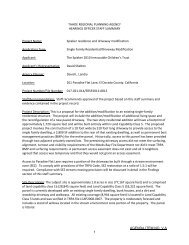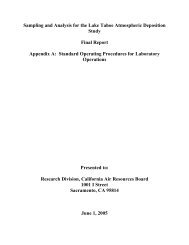FEIS - Tahoe Regional Planning Agency
FEIS - Tahoe Regional Planning Agency
FEIS - Tahoe Regional Planning Agency
Create successful ePaper yourself
Turn your PDF publications into a flip-book with our unique Google optimized e-Paper software.
RESPONSE TO COMMENTS ON THE DEIS<br />
B o u l d e r B a y C o m m u n i t y E n h a n c e m e n t P r o g r a m P r o j e c t E I S<br />
Fehr & Peers Mixed Use Development Model<br />
Methodology<br />
The Fehr & Peers mixed-use development model was developed using data from 239 mixed-use<br />
developments in six metropolitan regions (Boston, Atlanta, Houston, San Diego, Seattle, and<br />
Sacramento). While the data were collected in urban areas, the relationship between mixed uses<br />
can be applied to mixed-use projects in less urban areas. Hierarchical Linear Modeling (HLM)<br />
techniques were used to quantify relationships between characteristics of the mixed-use<br />
developments and the likelihood that trips generated by those mixed use developments will be<br />
made by means other than the private automobile. The mixed-use development model calculates<br />
the number of Alternative mode trips (trips made by walking, bicycling, transit, etc.) and<br />
determines the split between internal (walking between uses on the site) and external (walking,<br />
bicycling, or taking transit to a use off the site) Alternative mode trips.<br />
The Fehr & Peers mixed-use development model considers the following variables when<br />
analyzing mixed-use developments:<br />
• Employment<br />
• (Population + Employment) per square mile<br />
• Land Area<br />
• Total Jobs / Population Diversity<br />
• Retail Jobs / Population Diversity<br />
• Number of intersections per square mile<br />
• Employment within a mile<br />
• Employment within a 30-minute trip by transit<br />
• Average Household Size<br />
• Vehicles Owned Per Capita<br />
Many of these variables are examples of the "Ds", which are built environment variables that are<br />
known to influence travel behavior - density, diversity, development scale, design, and distance to<br />
transit.<br />
Validation<br />
A set of 16 independent mixed-use sites that were not included in the initial model was tested to<br />
help validate the model. The actual observed trip generation of the 16 test sites were compared to<br />
the trip generation estimated by the model. The model produced superior statistical performance<br />
when comparing the model results to observed data. Specifically, the trip generation estimated by<br />
the mixed-use development model better replicated the observed trip generation at the 16 test<br />
sites than trip generation estimated using the traditional ITE methods. For example, the statistical<br />
analysis comparing the observed trip generation to trip generation estimates from the traditional<br />
ITE methodology indicated an R-squared value of 0.58 (meaning the methodology explains about<br />
58 percent of the variability in trips). The statistical analysis comparing the observed trip<br />
generation to trip generation estimates using the mixed-use model indicated an R-squared value<br />
of 0.82 (meaning the methodology explains 82 percent of the trips).<br />
The mixed-use development model has been developed in cooperation with the US<br />
Environmental Protection <strong>Agency</strong> (EPA) and ITE. ITE is currently reviewing the model for<br />
potential inclusion in their updated recommended practice for evaluating mixed-use development<br />
SEPTEMBER 8 , 2010 HAUGE BRUECK ASSOCIATES PAGE 8- 19






